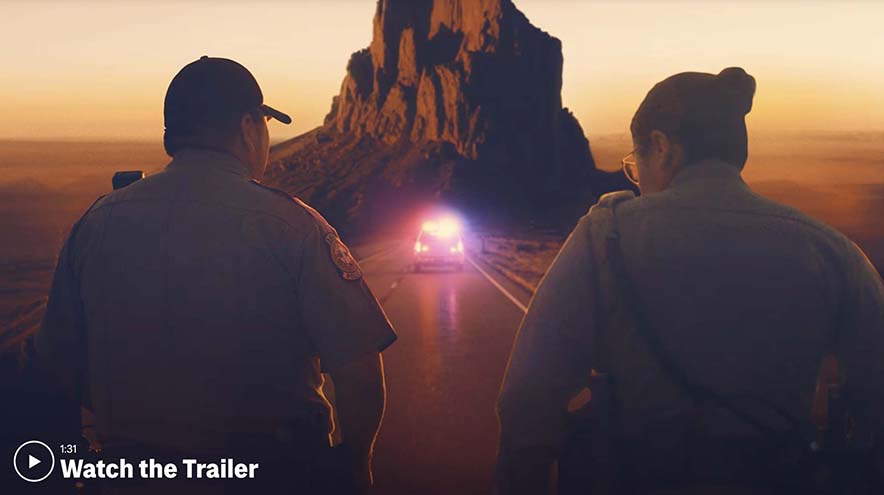
HBO features Navajo Police Department in a docuseries

Courtesy | HBO
Two Navajo Nation Police officers are in the foreground of Tsé Bit’ą’í near Naat’áanii Nééz/Toohdi, N.M., in this screenshot. Navajo Police: Class 57 is a three-part docuseries that follows a group of recruits as they fight their way through the Navajo Police Training Academy and out into the field.
WINDOW ROCK – In a three-episode HBO original documentary series, the country will get a first-hand look into the grit and grind behind the Navajo Police Department.
The series, “Navajo Police: Class 57,” is an original HBO series that strays away from a former stereotypical show on Navajo PD, “Navajo Cops,” which Flight 33 Productions produced for the National Geographic.
The new network series documents the journey of Class 57, a group of recruits working toward graduation day and becoming trained, certified Navajo Police officers.
The second episode of the documentary aired on HBO on Tuesday evening, Oct. 17.
Khalil Hudson, a director, producer, and creator of the series, has worked on films on the Navajo Nation before, but this time, he wanted to present a film on tribal sovereignty.
Hudson is Tlingit from Alaska and is currently a film professor at the Institute of American Indian Arts in Santa Fe, New Mexico.
In 2019, Hudson met with Chief of Police Daryl Noon and pitched the idea of doing a docuseries on the Navajo PD.
“The fact that the Navajo Police Department trains its own officers, and it’s the only tribal police force that trains its own officers, is an act of tribal sovereignty and asserting that tribal sovereignty,” said Hudson.
Nothing like NatGeo’s ‘Navajo Cops’
Hudson assured Noon the series would be nothing like the show “Navajo Cops,” which he found exploitative and did not realistically show the officers or the people they serve.
Rather than following crime and touching the surface of a day in the life of a Navajo police officer, Hudson wanted to organically and truthfully show the work that Navajo police officers do.
While embracing the lifestyle of the officers, Hudson was surprised at how vast the Navajo Nation is and how there are not a lot of officers to cover the tribe’s entire land.
“There’s not enough officers to patrol together. They’re patrolling by themselves in police cruisers, which is unlike most of the country,” said Hudson.
With the vast land comes long-distance drives and long workdays.
When officers are called to go to a home that sits an hour from their station, they must drive an hour back or an even longer distance if they get another call.
Hudson compared law enforcement in the Nation to the city, and the difference was that in one community, it can take hours for needed assistance to arrive, whereas in the other, help is right around the corner.
“It’s just not possible on Navajo,” said Hudson.
Modern-day ‘monsters’
During the creation of the film, Hudson learned about Naayéé’ Neizghání and Tóbájíshchíní, the Hero Twins, in the Navajo creation stories. Hudson viewed the Navajo PD as the modern-day version of the twins combatting modern “monsters.”
“The twin warriors were evoked multiple times. They were evoked at graduation, they were talked about in initial interviews as guiding principles for policing,” said Hudson.
Discussing a preview of the series, Hudson said it opens with a community meeting where Crownpoint community members share their complaints about the Crownpoint Police Department.
Hudson said he wanted to ensure there wasn’t only one perspective shown.
During a moment in the film, Shandiin Yazzie, a member of the K’é Infoshop, talks about what is wrong in the community and where the disconnect lies between law enforcement and the community.
Hudson listened to Yazzie’s explanation of k’é and the community and said they used some of her ideas throughout the film to show what k’é is in the community.
One noted difference between Navajo police officers and non-Navajo police officers is that they’re Navajo, and with that comes tribal protection ceremonies and traditional protection practices.
A Navajo officer spoke candidly to Hudson about how the Hero Twins got sick because they didn’t protect themselves, and Hudson alluded to that sentiment in the film.
Behind the badge
The film intends to cater to both Navajo and non-Navajo audiences.
Hudson included the Class 57 cadets with their humor and all-around personalities that Navajo people could relate to and show non-Navajo audiences that Native people and communities exist today and share similar qualities.
“Some of them (non-Natives) don’t even know Natives exist, and if they encounter a Native on the street, they wouldn’t know that that’s a Native. They’re expecting someone with feathers wearing moccasins because that’s what they see,” said Hudson.
There is much more than just the firearms and badges of the Navajo Police Department. Hudson and other directors and filmmakers want to show what lies behind the badge – the heart and pride of each cadet and officer wishing to protect their people.








 Highway 264,
Highway 264, I-40, WB @ Winslow
I-40, WB @ Winslow